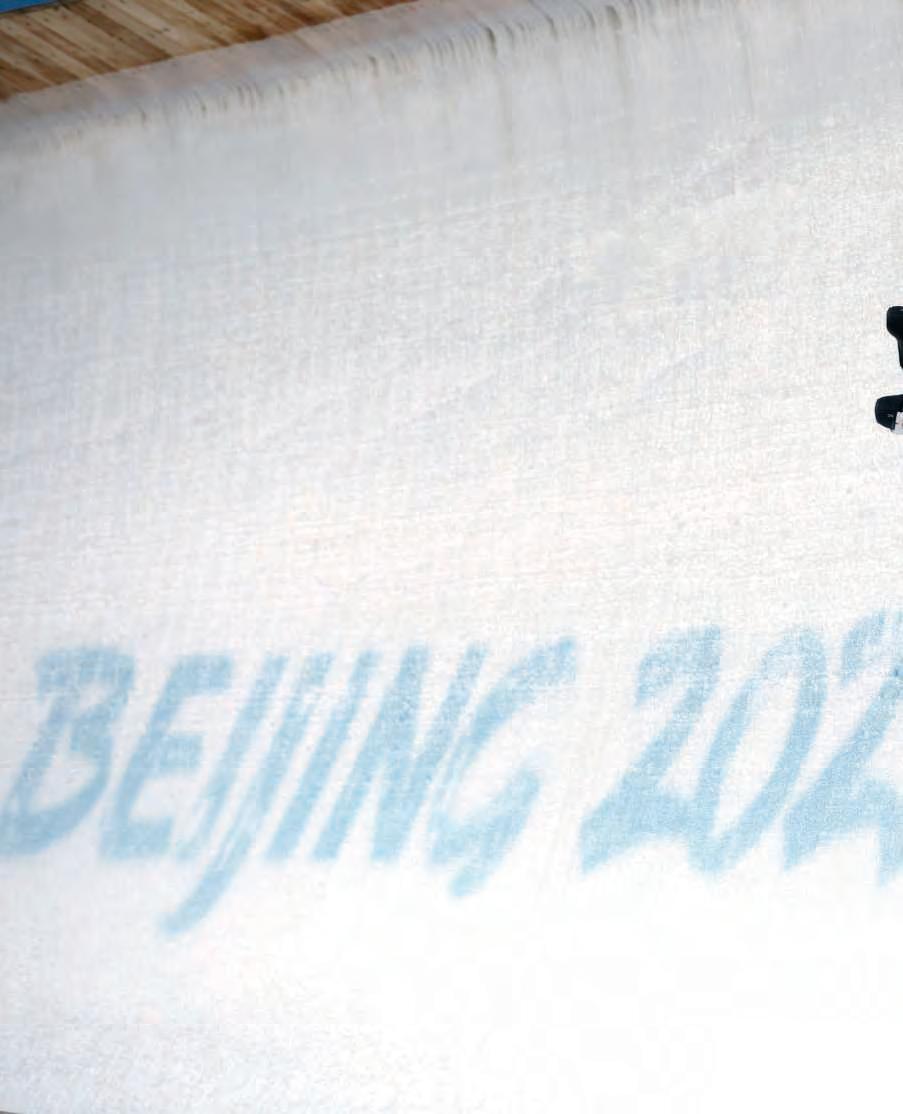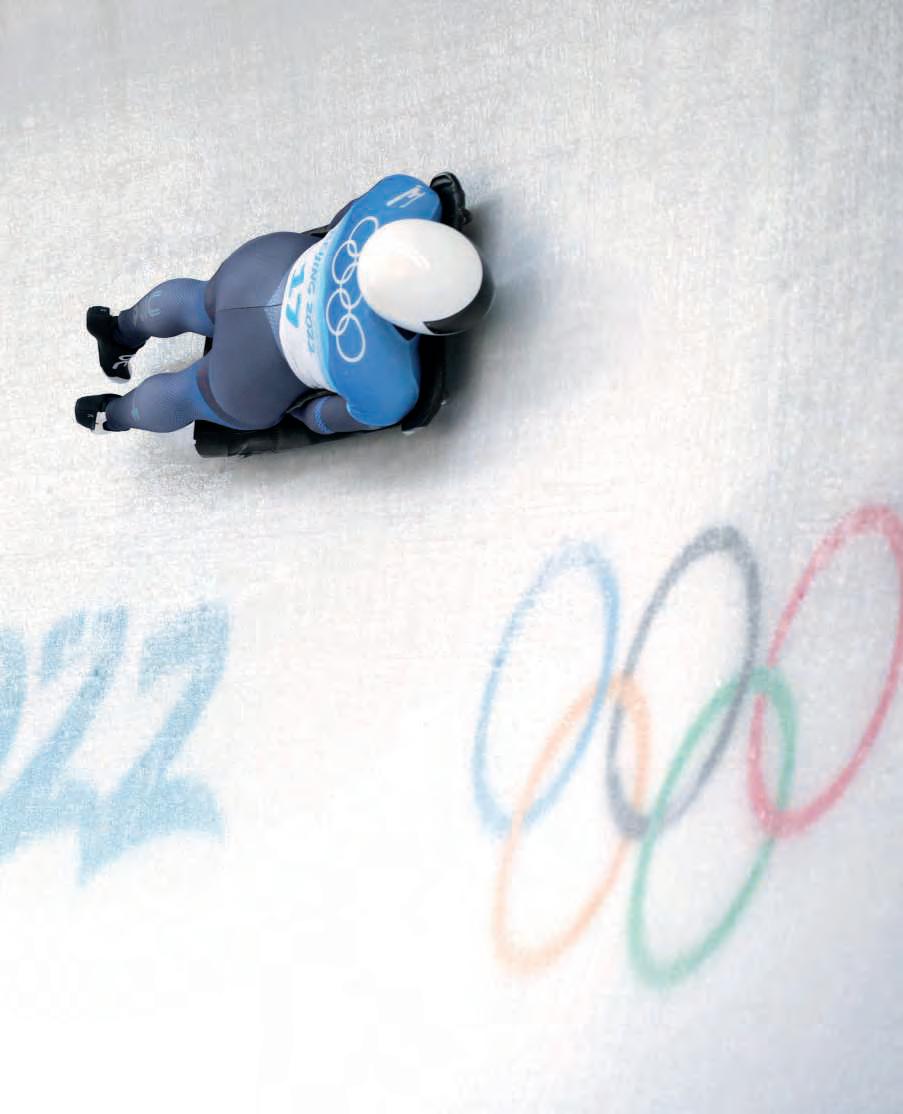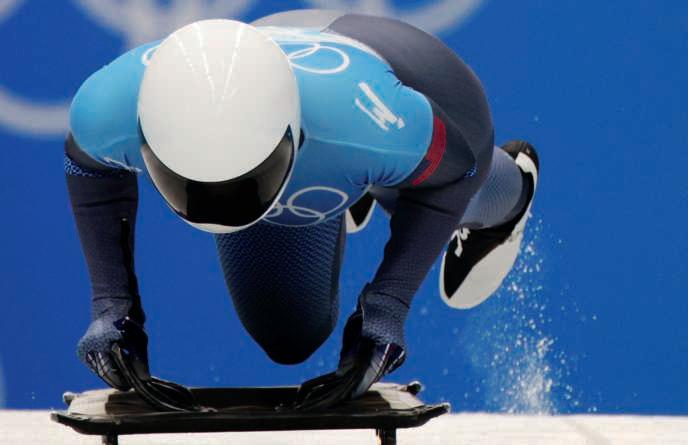
9 minute read
KELLY CURTIS
Fast Track
Ten years after she graduated from Springfield College, Kelly Curtis made history as the first Black skeleton athlete to compete in the Olympics for Team USA.
Advertisement
By Collin Atwood
Photography by Springfield Athleticsand Getty Images
Heading into the final event of the heptathlon at the 2012 NCAA Division III Track and Field Championships in Claremont, Calif., Kelly Curtis held sole possession of first place with the second place competitor trailing by 81 points. After six grueling events, the odds of the New Jersey native running away with the title were becoming more likely.
As a senior in college who had a lifetime of athletic competitions under her belt, finishing her collegiate career on top would have been ideal. Unfortunately, Curtis came down with a sickness that made the 800-meter run particularly challenging.
She excelled in every other event of the heptathlon, but when it came down to the finale, Curtis huffed and puffed her way to 18th place. This final run – of the competition and her college career – resulted in her dropping to fifth on the leaderboard.
Little did John or anyone else know, Curtis’ competitive days were only just beginning.
After Curtisgraduated fromSpringfield College in 2012, she made her way to St. Lawrence University to pursue a masters degree in educational leadership. But because of her strength and conditioning coach at Springfield,DanielJaffe, she decided to put her attention somewhere else.
Jaffe thought that Curtis possessed the necessary abilities - power, explosiveness and speed - that it took to be successful in the sport of bobsled.
Her skillset reminded Jaffe of another heptathlete who competed for the Pride, which led to him promoting the fast-paced sledding sport to Curtis. This particular athlete was Erin Pac Blumert ‘03, who earned a bronze medal in bobsled at the 2010 Olympics in Vancouver, British Columbia.
Jaffe’s assessment of Curtis’ skills were correct. After trying bobsled in the summer of 2013, she was invited to a driving school in Lake Placid, a village in the Adirondack Mountains in New York, that December.
In the midst of learning how to be a better sled driver, Curtis’ attention was drawn to a different sport that involved sliding 80 miles per hour on the ice. She noticed other people sliding down hills on a skeleton sled and thought that she’d give it a try.
Curtis said. “The people in that sliding school looked like they were having a lot more fun than I was driving a bobsled.”
Rather than sitting upright in a bobsled that is built like a miniature car, she preferred to dive head first, where the only thing stopping her from falling off were two pieces of metal pressed to the body. She liked to slide.
From that point on, Curtis committed her time to becoming a world-class skeleton athlete.
The only way to be successful at a sport that not a lot of people participate in or even know about is to give it your all.
“Coming into our sports of bobsled and skeleton, you definitely had to have a strong mindset, determination and a lot of dedication to the sport,” Blumert said.
Curtis’ hard work and dedication proved fruitful in 2017 when she won the gold medal at the Women’s Skeleton North America Cup at Lake Placid and again at the Whistler Sliding Centre in British Columbia.
Her most important world cup event took place on Jan. 14, 2022. Although she didn’t medal, the result of her last ride down the trackatSt.MoritzOlympia BobRun in Switzerland was nothing short of spectacular.
To qualify for the Olympics, Curtis had to be ranked in the top two for women skeleton athletes in America. Going into her final ride at St. Moritz, a track she had never gone down, Curtis needed a miracle to bridge the gap between her and the other American athlete ranked higher than her.
As she came across the finish line, Curtis recorded a personal best and finished sixth at the BMW IBSF World Cup. This tremendous feat pushed her ahead of her fellow American on the leaderboard.
“For me to be able to pull it out on a track that I had never been to, in Switzerland, was unbelievable,” Curtis said.
Curtis’ next stop: the 2022 Beijing Olympics.

This pastFebruary,
Curtis made her Olympic debut in Beijing. “I’m still digesting,” Curtis said. “It was a whirlwind for sure.”
Curtis competed in three out of four heats at the Olympics. She needed to finish in the top 20 at the end of heat three to have a chance at a medal. By the end of her third run, she was one spot short of advancing with a total time of 3:09.23.
Although she didn’t medal or perform the way she had hoped, her appearance at the Olympics was about much more than sliding down a track as fast as possible. Curtis became the first Black skeleton athlete to compete in the Olympics for Team USA.
“To think about the journey that my family has made throughout the generations for me to get to this point, I’m just extremely proud to be here and to represent everything that [my parents] have gone through,” Curtis said.
Many supported Curtis for this accomplishment, but she also received some backlash from people who didn’t recognize her as being biracial.
“I don’t typically present as Black to a lot of people, so I think a lot of people found it challenging to recognize me as being the first, but I am,” Curtis said.
This behind-the-scenes controversy messed with Curtis’ mindset going into the Olympics, but she says that she will try to not let non-skeleton related issues bother her in further competitions. *****
Curtis’ eyesare now set on the 2026 Olympics in Milan, Italy. In fact, shortly before her Olympic debut in Beijing, Curtis and her husband moved to Italy to get familiar with the tracks there. Now, the 33-year-old can train for the next four years right in Milan’s backyard.
“It’ll almost be like a home track to her,” John said.
While Curtis is training, she will also be serving as an airman at the Aviano Air Base in northeastern Italy. Curtis enlisted in the U. S. Air Force in 2020 and quickly joined the World Class Athlete Program.
The WCAP is a military unit that specifically allows soldiers to participate in the Olympics. Curtis was a member of this program while she trained for the Beijing Olympics.
“It has not been difficult to balance because the Air Force has put the emphasis on me representing them at this level of competition,” Curtis said.
Curtis’ entire life has revolved around balancing responsibilities. As a kid she played softball, basketball and wrestled. By the time she hit middle school, she wanted to try track and field as well after she went to the Penn Relays with her father.
Being involved in athletics was “encouraged by the family,” John said. Curtis grew up with two older brothers and they were very involved in athletics.
John was also very involved in athletics. Before he graduated from Springfield College in 1971, John played football, baseball and also ran track and field. His success came on the football field and he ended up getting drafted to the New York Jets in the 11th round of the 1971 NFL Draft.
Going into college, Curtis decided to focus on track and field. Before running for Springfield in 2010, Curtis enrolled at Tulane University. During her time there, she realized that Springfield College


BEIJING 2022
Kelly Curtis ‘12, who competed in the heptathalon for the Springfield College track and field team as an undergrad, made her debut on the Olympic stage in the 2022 Winter Games.
would be better for her career path.
“I knew that the Springfield sports management program was world renowned and they would definitely have connections that I could use later on in life,” Curtis said.
The path to Alden Street was inevitable for Curtis. Not only did her father play for the Pride, but so did her brother. Curtis followed her brother into multiple things, including the Air Force and wrestling.
“Going to Springfield was almost like going back home because I would go there basically every year growing up as a child for my dad’s homecoming and to go watch my brother play football,” Curtis said.
Curtis remains in the record books at Springfield College to this day. She holds the record in the 60-meter hurdles for indoor track and field with a time of 9.22. During her collegiate career, Curtis also won the heptathlon at the Penn Relays in 2011.
Seeing his daughter make it to the Olympics through an unconventional sport was just as mind blowing for John. He realized that Curtis’ determination would lead her to success in anything she put her mind to.
“Her mother and I couldn’t actually believe what we’ve seen,” John said.
The US Olympic Committee flew Curtis’ father, mother, husband and brother-in-law out to Park City, Utah to watch her Olympic debut. Along with them were hundreds of family members of other Olympic athletes.
All of the family members stuffed into one room inside of the Hilton Hotel. The room was filled with one large screen and a few other smaller screens. The more popular the sport, the bigger the screen they appeared on.
Curtis’ first run aired at around 7 p.m. in Utah. By that time, 50 people were gathered around one of the smaller screens to see her slide. Her family rose from their seats and cheered her on with signs that read, “Go Kelly” and “Team USA.” Too nervous to eat, her family watched Curtis make Olympic history for Team USA.
“It was something I’ll never forget,” John said.









